TECO’s San José Plant Models Safe and Sustainable Practices
In operation since 2000, TECO Energy Inc.’s 132-MW San José Power Station was the first coal-fired power plant built in Central America and is still the largest one. Used as a baseload plant, the facility successfully combines high availability with a business model that promotes sustainable environmental practices and a safe workplace.
Guatemala has a fascinating history that includes a millennia of Mayan civilization and three centuries of Spanish rule. Today, the country is looking for new ways to create a brighter future for its citizens. For example, the Central American Free Trade Agreement entered into in July 2006 is spurring increased investment and diversification of exports; the largest increases are in ethanol and nontraditional agricultural exports. In addition, the country is becoming an increasingly popular tourist destination due to its outstanding natural beauty, unique ecosystems, and large number of Mayan archeological sites.
A representative democracy, Guatemala has a population of approximately 13,550,440. Sugar production, textiles and clothing, furniture, chemicals, petroleum, metals, rubber, and tourism are its main industries. Guatemala’s electricity production and consumption were approximately 8.425 billion kWh and 7.115 billion kWh (2007 estimates), respectively. Recent statistics show that the country exports approximately 131.9 million kWh of electricity annually.
In order to promote increased prosperity in Guatemala, the most populous Central American nation, abundant and reliable electricity is required. To meet this growing need, TECO Energy Inc. and two partners started construction of the San José Power Station in 1998 as an investment. During construction, TECO bought out the other partners to become the sole owner. The plant was commissioned by the end of 1999 and went commercial on January 19, 2000 (Figure 1).
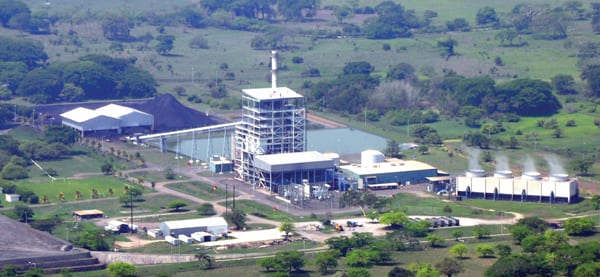 |
| 1. Pacific powerhouse. The 132-MW San José Power Station was the first coal-fired power plant built in Central America and is still the largest one. Courtesy: TECO Energy Inc. |
“The San José Power Station has a 15-year power purchase agreement with the local distribution utility for the first 120 MW and has another 12 MW available to sell to the spot market,” Mauricio de la Torre, the San José Power Station plant manager, told POWER. “Since the plant began commercial operation, it has been dispatched on a baseload basis, with very little load swings through the year. The plant keeps a very high PPA availability of above 96%.”
Plant Overview
The San José Power Station is located near the town of Masagua, Guatemala, about 75 kilometers (km, 47 miles) south of Guatemala City, the nation’s capital. Included in the project’s scope is a fuel-receiving facility located at Puerto Quetzal on the Pacific Coast, 40 km away.
The plant was constructed under a contract with J.A. Jones Construction and Black & Veatch International on a turnkey basis. The project included port modifications to accommodate the importation of coal, as well as a transmission line to connect the plant to the Alborada substation.
The project consists of a coal-fired boiler, condensing steam turbine, cooling tower, and a substation (Figures 2 and 3). Low-NOx burners and a pulse jet fabric filter complement the low-sulfur coal used as fuel.
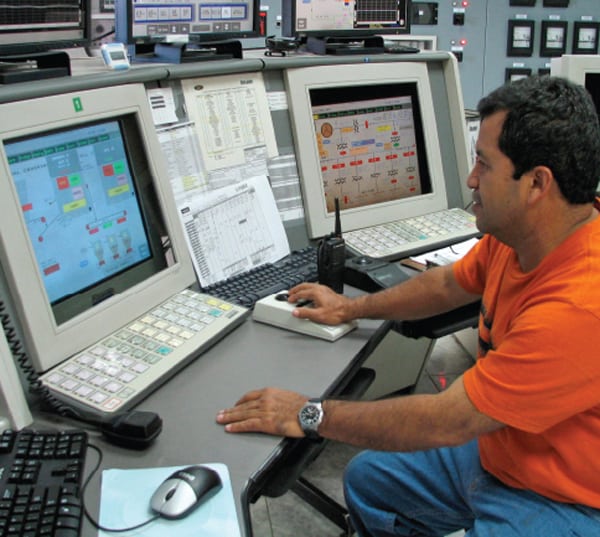 |
| 2. 21st-century know-how. The San José Power Station, including the control room shown in this photo, contains current technology that allows it to operate with great efficiency. Courtesy: TECO Energy Inc. |
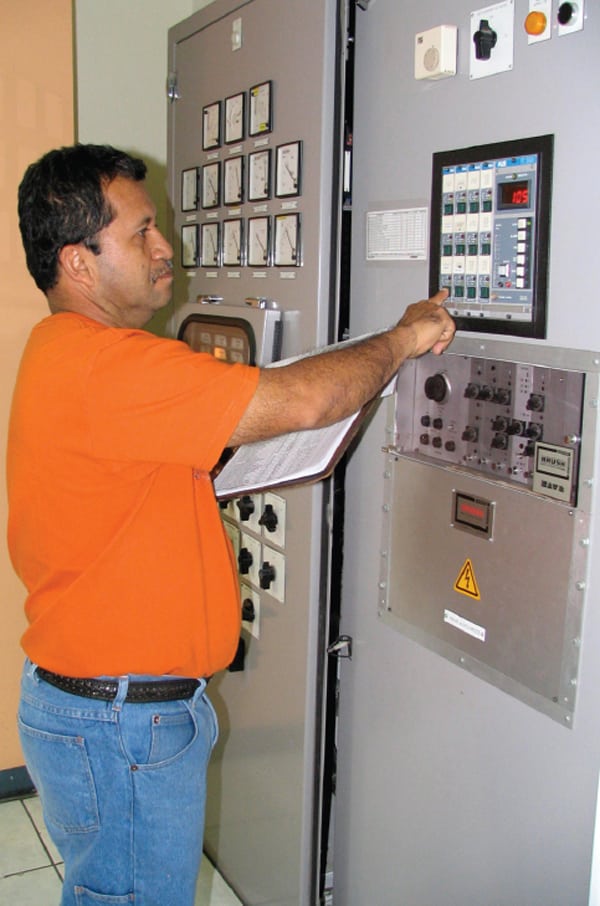 |
| 3. Keeping things under control. San José’s control room is the nerve center of the facility. Courtesy: TECO Energy Inc. |
The plant has a DB Riley, coal-fired furnace with three duplex, Atrita pulverizers feeding 12 burners in three rows of four burners each. The boiler feeds about 1,200 kpph of 1,000F/1,905 psia superheated steam to the turbine.
The single-flow, 11-stage Mitsubishi turbine has five steam extractions and a closed-loop condensing system that utilizes cooling water from a four-section cooling tower. The generator is a 160-MVA, three-phase, 60-Hz, brushless generator made by Brush (England), directly coupled to the high-pressure side of the turbine. The plant also has a 43.2-MVAR capacitor bank to assist with reactive power.
“All the water used at the power plant comes from seven wells, with the main problem being a high silica content due to the fact that the plant is in a volcanic region of Guatemala,” de la Torre said.
The plant’s electric output is sent via a 17-km 230-kV power line to a substation near the city of Escuintla, where it is connected to the national grid.
Operating with an overall efficiency of 10,800 Btu/kWh, the plant generates close to 1,000 GWh annually. That total may vary, depending on the rainy season and the dispatch of hydro plants. Scheduled maintenance requires between 18 and 30 days per year, and the plant has an annual availability of approximately 98%.
The Plant’s Coal Usage
Almost all the coal used at the plant comes from Colombia. It is unloaded at the plant’s unloading facility close to Puerto Quetzal on the Pacific Ocean and then is transported to the plant site by a company-owned fleet of trucks that make approximately 70 shipments per day, six days a week. At full load, the plant consumes about 1,300 tons of coal per day (Figure 4).
 |
| 4. From coal to electrons. The plant’s coal-handling area is shown. At full load, the plant consumes approximately 1,300 tons of coal per day. Courtesy: TECO Energy Inc. |
“Most of our coal comes from the Atlantic Coast of Colombia in South America. And because [the plant] is located on the Pacific coast, that means that each coal shipment goes through the Panama Canal,” de la Torre said. “We have used coal from Canada in the past, but the severe winters and higher price has discouraged us from using it.”
One limitation is that all coal vessels must be self-unloading, due to the design of the port facility, de la Torre pointed out. This requirement narrows the availability of coal transport vendors.
Workforce Challenges
The San José plant is staffed by 76 employees, including the plant manager, an operations manager, a maintenance manager, eight staff engineers, miscellaneous office staff, and five shift crews each composed of eight workers. TPS Operaciones de Guatemala Ltd. is responsible for plant operations.
“We have found that technically prepared individuals are extremely difficult to find in a country whose main economy is based on agriculture,” de la Torre said. “In order to retain our staff, our company has a policy of keeping salaries and wages within the ‘top five’ in the country. Being the first coal-fired plant in the area requires a lot of training, and today only an 18-MW coal-fired plant has been added to the Guatemalan grid, although others are under construction.”
Another challenge is language, according to de la Torre. Most technical publications, books, and manuals are in English, so learning a second language has been a big challenge for the plant’s Spanish-speaking employees.
“The third challenge is to develop a culture of safety,” he said. “There are very low standards in the Guatemalan industry regarding safety and environmental compliance; however, there are several companies—including TECO Guatemala—with high standards. Creating a safe environment has required a continuous effort since day one.”
The San José plant adheres to Guatemalan and U.S. standards, including those enacted by the Environmental Protection Agency and the Occupational Safety and Health Administration.
TECO Guatemala invests time, resources, and money to train its team members by providing the tools for their personal and professional growth. TECO Guatemala also offers safety and first aid training to team members and their families, which mutually benefits the company and its employees.
Making Safety and a Clean Work Environment Top Priorities
TECO Guatemala has developed an excellent safety culture in-house with a lot of effort, de la Torre explained. The company believes in a healthy, clean, and safe environment, which is why it has environmental, health, and safety (EHS) programs that include ergonomics, occupational health and safety, and research of incidents. EHS training is conducted throughout the year and is based on activities that are being developed in the plant.
“We recognize that a clean working environment is part of a safer and healthier environment,” he said. “Any maintenance and operations activity is not considered ‘closed’ until the area is left clean and organized. This is partially our way of trying to always incentivize pride for a clean work area. Cleaning the work area is included in most work orders, so the work order cannot be closed until the area is clean” (Figure 5).
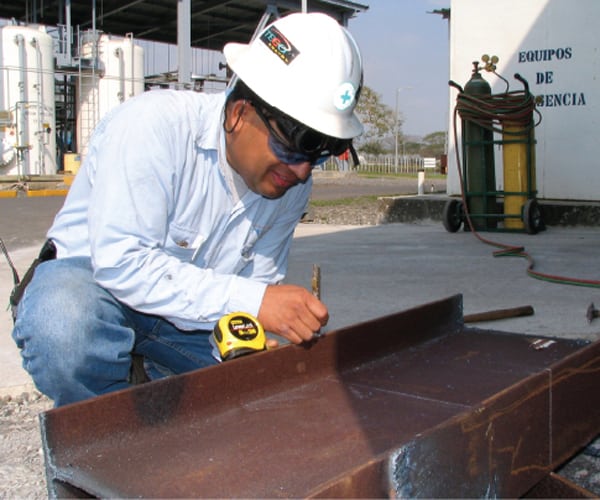 |
| 5. Neat and tidy. One of the TECO staff is shown working outside. Note the cleanliness of the work area. TECO plant management tries to foster pride in having a clean work area. Courtesy: TECO Energy Inc. |
“In addition, we must be fair about explaining the type of plant that we have,” de la Torre explained. “Our boiler is a ‘balanced draft,’ which of course helps a lot in avoiding having coal dust around.”
Plant employees are also challenged to perform each job within an established time frame. The time to complete each work order and the number of work orders that have to be repeated due to human error are also factored into the merit pay each employee receives at the end of the year. However, plant management has learned that the pride each employee exhibits in his or her work is considerably more effective than any bonus-penalty scheme the managers may use.
Reaching Out to the Community
TECO Guatemala’s plan for community involvement began in 2003 with the donation of construction materials and voluntary employee help for improving several areas of education, de la Torre explained. Since providing this assistance, TECO Guatemala has constructed complete schools, individual classrooms, and sanitary services; repaired damaged areas and peripheral circulation; and helped with specialized programs, such as parent schools and reading programs (Figure 6). The company’s goal is to help develop productive young men and women. TECO has assisted more than 20 schools in the department (state) of Escuintla and enabled more than 3,700 children to have access to adequate educational facilities.
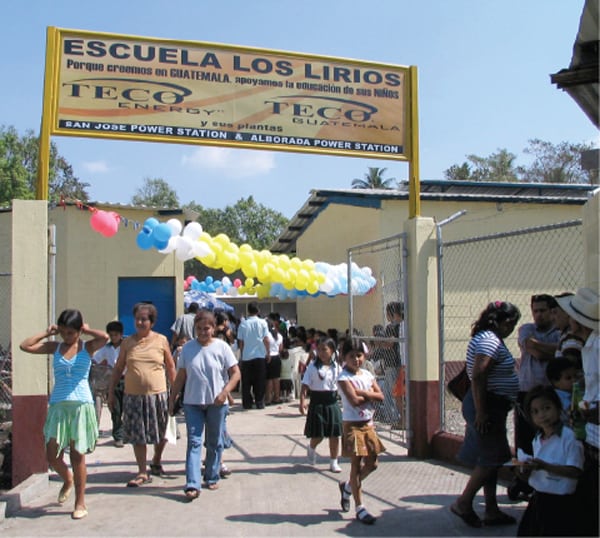 |
| 6. Giving a helping hand. One of TECO Guatemala’s social outreach projects is shown. The company builds schools that offer classes year-round. Courtesy: TECO Energy Inc. |
In addition, the company has donated desks and chairs for students and faculty. One of the projects with a high impact began in 2007 with construction of the “Escuela Modelo de Autogestión Comunitaria” (model school for community self-sufficiency) of the aldea (town) of Los Lirios in Masagua, Escuintla. TECO Guatemala donated Q2.5 million quetzales (US$317,379), which were used to build 18 classrooms, an office for the school director, a multiple use room, a physical activity area, a soccer field, a basketball court, and five bathroom modules.
TECO Guatemala has also provided assistance for some University of del Valle of Guatemala projects by donating scholarships and helping students who have attended the MERCOSUR Cultural Educational Meeting in Argentina. All together, TECO Guatemala has donated approximately US$1.5 million in projects for community assistance since 2002.
Editor’s Note: After this issue went to press, we learned that the plant received the "premio de Gran Ganador" (Prize of Grand Winner) from the American Chamber of Commerce for the facility’s social
outreach programs to the community.
— Angela Neville, JD, is POWER’s senior editor.